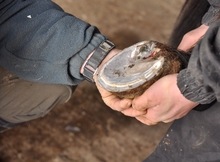Knowing three rules for treating an injured horse can help you not only effectively treat the injury, but also may help save your horse's life.
- Always stay calm and call for help when your horse is injured.
- Make human safety your first priority; the horse should be safely restrained when an injury is being treated.
- Avoid contamination or further damage of any open wounds or broken bones.
How to treat the most common horse injuries
- Bleeding: If blood is spurting, an artery is involved. Apply pressure either with your hand or a piece of material and, if necessary, make a tourniquet from a towel or piece of cloth and apply a tourniquet between the heart and the wound to stop the flow of blood.
Be sure to loosen the tourniquet every 15 minutes to allow blood flow to resume temporarily. If blood is oozing from a vein, apply pressure with a clean, absorbent material until the bleeding stops. Keep the horse calm and if injury is severe, call your veterinarian.
Caution
Use a tourniquet only as a last resort and under the direction of a veterinarian.
- Animal bites: Cleanse the bite area with a Betadine or Nolvasan solution used as a lavage. Gently enlarge the open area of any teeth marks for thorough cleaning and to provide drainage. If the bite is surrounded by long hair, clip the hair back. Unless the bite is severe, the wound should be left open, but kept clean and medicated daily with a topical antibiotic ointment.
- Abrasions: Abrasions occur when a horse's skin is scraped against a rough surface during a fall or accident or when saddles or blankets rub the skin away causing a painful surface wound that may bleed.
The area where the abrasion is located should be cleansed with a Betadine scrub solution and an antibiotic ointment should be applied. Ordinarily, it is best to leave the abrasion open to the air for quicker healing. - Lacerations: Lacerations are cuts on the horse's body or limbs. If the laceration is minor, it may be flushed out with water from a garden hose or spray bottle to get rid of any foreign materials such as dirt, grass, or gravel.
- Puncture wounds: Because of the danger of bacteria penetrating deep into the horse's flesh, puncture wounds are considered the most serious. In the case of a puncture wound, do not attempt to stop bleeding which can help flush out bacterial. Call your veterinarian since a series of antibiotic injections will be necessary. The external opening of the puncture wound should be opened and the tract should be irrigated with a diluted antiseptic surgical scrub solution. If the puncture wound is in the hoof, special attention from the veterinarian is important to prevent infection from traveling up the horse's leg.
- Broken or fractured bones: Many factors enter into the treatment of broken or fractured bones including the site of the break or fracture, whether or not it is involved in direct weight bearing, the age of the horse, and the resources available for treatment.
Most fractures of the long bones in the leg have a poor prognosis, but the first step is to prevent further damage to the bone and surrounding muscle and ligaments. Generally first aid includes keeping the horse calm and stabilizing the fracture site with a layered bandage and a carefully applied splint which may be made of anything light weight and rigid. Immobilizing the joint above and below the fracture is of the utmost importance.
If the veterinarian can come to where the horse is located, that works for the best. If the horse must be transported to a veterinarian hospital, measures must be taken to minimize movement and keep the horse steady in the trailer.

Checking a hoof for a puncture wound
Puncture wounds on the sole of the hoof are very serious. Contact your farrier or vet if you find a hoof puncture.
